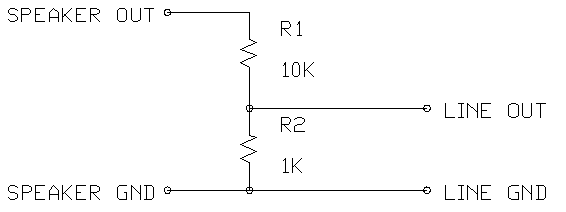Best way to connect power amp to smaller integrated
Making line level converter using this design. The source amp is 50 wpc, the power amp is 200 watts per channel.
Would this resistor specs be correct?
What resistor size in watts do I need ?
Is this the best way to connect a power amp to a smaller integrate ?

Making line level converter using this design. The source amp is 50 wpc, the power amp is 200 watts per channel.
Would this resistor specs be correct?
What resistor size in watts do I need ?
Is this the best way to connect a power amp to a smaller integrate ?

Last edited:
50 wrms/8ohm is 20 volt rms.
Your divider will give about 1.8 volt rms unloaded. These are impossible to calculate (from how it will sound subjectively) but your values are a good starting point. Why not make the 1k a preset and get the level that works best... then replace with a fixed resistor.
The 10k needs to be at least 50 milliwatts rated 😉 Just use a 0.5 watt metal film for a real build. The 1k dissipates far less.
Your divider will give about 1.8 volt rms unloaded. These are impossible to calculate (from how it will sound subjectively) but your values are a good starting point. Why not make the 1k a preset and get the level that works best... then replace with a fixed resistor.
The 10k needs to be at least 50 milliwatts rated 😉 Just use a 0.5 watt metal film for a real build. The 1k dissipates far less.
I recently read about the Musical Fidelity supercharger power amp that uses the speaker output of a smaller amp and uses it as the signal. Does it use the similar circuit that I posted above or is there a better design for this requirement ?
it depends...
You can make amplifiers with low voltage gain, for example a power 'buffer' would have a gain of just 1.
It is up to the designer what gain they use. Your divider typically suits a normal power amp output stage feeding another normal power amp input (which would be line level).
So if you wanted to make a dedicated power amp to work purely from the speaker feed of another amp you either have a resistive attenuator such as yours (and a normal gain power amp) or you purposely design the power amp for low voltage gain.
There are trade-offs for both approaches. It is considered 'bad practice' to attenuate a signal only to have to amplify it again, however the downside of making a low voltage gain power amp to avoid doing that is that these often have other issues to look at such as stability margins.
You can make amplifiers with low voltage gain, for example a power 'buffer' would have a gain of just 1.
It is up to the designer what gain they use. Your divider typically suits a normal power amp output stage feeding another normal power amp input (which would be line level).
So if you wanted to make a dedicated power amp to work purely from the speaker feed of another amp you either have a resistive attenuator such as yours (and a normal gain power amp) or you purposely design the power amp for low voltage gain.
There are trade-offs for both approaches. It is considered 'bad practice' to attenuate a signal only to have to amplify it again, however the downside of making a low voltage gain power amp to avoid doing that is that these often have other issues to look at such as stability margins.
That's really only within one piece of equipment, where the headroom is a finite resource that would be squandered by having voltage gain that you then throw away again.It is considered 'bad practice' to attenuate a signal only to have to amplify it again
In between equipment you may have to attenuate as here if the levels are too high and would burn-out the front end of the destination....
Yes, that is true as far as it goes Mark.
The big question here is whether the power amp that was mentioned:
is a normal type amp or more of a buffer or very low gain design designed exclusively for accepting a speaker feed as an input.
The big question here is whether the power amp that was mentioned:
the Musical Fidelity supercharger power amp
is a normal type amp or more of a buffer or very low gain design designed exclusively for accepting a speaker feed as an input.
Following on from this topic, I have an 18W First Watt amp -I was interested in the Musical Fidelity superchargers as well, but they have a gain of approximately 3.16 (source: Power-Booster Amplifiers) - so the supercharger is only really intended to supplement driving the whole loudspeaker as it wouldn't be gain matched for my application of running MT from the First Watt and W from the supercharger.
Seems that the sensible option for running W off the first watt is to use Hypex FA521 or 501 plate amplifier that have high level (speaker level) inputs. Put them in free standing enclosures and you have a modern MF supercharger, with the benefits of DSP.
Any other suitable options?
Seems that the sensible option for running W off the first watt is to use Hypex FA521 or 501 plate amplifier that have high level (speaker level) inputs. Put them in free standing enclosures and you have a modern MF supercharger, with the benefits of DSP.
Any other suitable options?
- Home
- Amplifiers
- Solid State
- Resistor ratings for line level converter